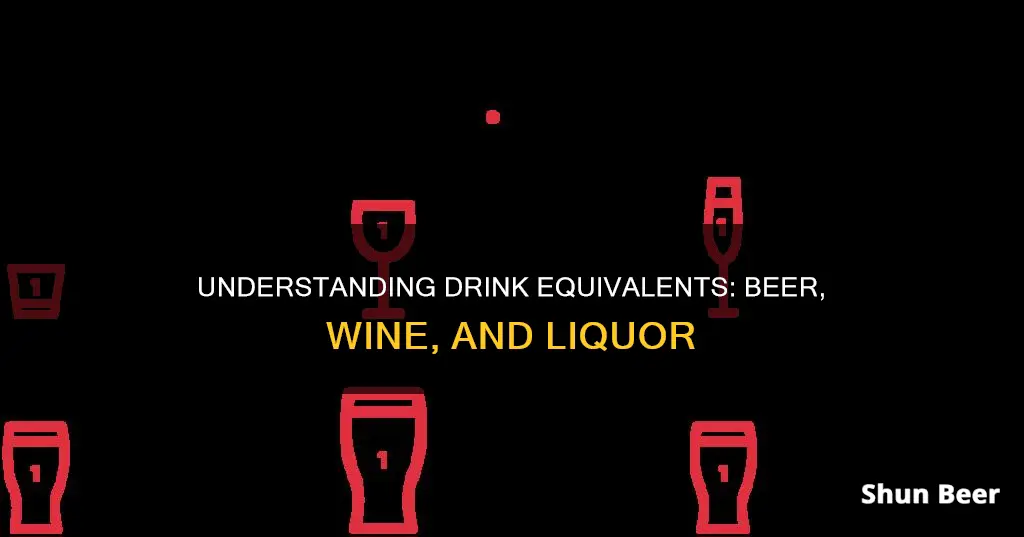
How much alcohol is considered a standard drink varies across different countries and beverages. In the United States, one standard drink or alcoholic drink equivalent contains roughly 14 grams of pure alcohol, which is found in 12 ounces of regular beer, 5 ounces of wine, or 1.5 ounces of distilled spirits. However, the amount of liquid in your glass may not correspond to the amount of alcohol it contains. For instance, many light beers have almost as much alcohol as regular beer. Similarly, most wines today have a higher alcohol content than 12%. Therefore, it is important to be aware of the alcohol content of your drink and understand that one beer or cocktail may not equal one standard drink.
| Characteristics | Values |
|---|---|
| Beer | 12 ounces |
| Wine | 5 ounces |
| Liquor | 1.5 ounces |
| Alcohol Content in Beer | 5% |
| Alcohol Content in Wine | 12% |
| Alcohol Content in Liquor | 40% |
| Alcohol Content in Light Beers | 4.2% or 4.5% |
| Alcohol Content in Craft Beers | 8-9% |
What You'll Learn

Beer: 12 ounces, 5% alcohol content
In the United States, a "standard drink" is defined as containing roughly 14 grams of pure alcohol. This is equivalent to 0.6 US fluid ounces (18 millilitres) of ethanol. A 12-ounce (350 millilitres) can of 5% beer is considered a standard drink.
The amount of liquid in your glass, can, or bottle does not necessarily correspond to the amount of alcohol in your drink. Different types of beer, wine, or malt liquor can have varying alcohol content. For example, many light beers have nearly as much alcohol as regular beer, about 85%. Regular beer typically has an alcohol content of 5%, while light beers measure around 4.2% to 4.5%. As craft beers have gained popularity, so has their alcohol content, with some craft beers containing 8% to 9% alcohol. This means you might feel the effects after just one beer.
It's important to be aware of what you're drinking and understand that one beer or cocktail may not equal one standard drink. Using the National Institute on Alcohol Abuse and Alcoholism guidelines for standard drinks can help you monitor your alcohol intake and drink more responsibly. Knowing the alcohol content of your drink can help you make informed decisions about your consumption and avoid drinking too much.
The definition of a standard drink varies from country to country, and there is no international consensus on how much pure alcohol it contains. Values range from 8 to 20 grams (0.28 to 0.71 ounces) across different countries, with some countries adopting the World Health Organization's example of 10 grams (0.35 ounces) in their guidelines.
Beer and the Flu: A Safe Mix?
You may want to see also

Wine: 5 ounces, 12% alcohol content
In the United States, a standard drink or alcoholic drink equivalent contains roughly 14 grams of pure alcohol. This is the amount found in 5 ounces of wine, which is typically about 12% alcohol.
When pouring yourself a glass of wine with dinner, it's important to keep in mind that you're likely drinking more than the standard amount if you're simply filling a wine glass. Wine glasses are larger than the actual serving size, which can make it difficult to measure. To ensure you're pouring the correct amount, try using a liquid measuring cup or filling a dry measuring cup to just below the 2/3-cup mark.
The standard drink amount is helpful for following health guidelines, but it may not reflect customary serving sizes. The amount of alcohol in a drink can also be different if it's not measured appropriately. For example, beverage servers may provide drinks with more or less alcohol than the standard amount.
In the UK, a small glass of wine (50 ml or 1.7 US fl oz) of sherry, fortified wine, or cream liqueur (around 20% ABV) contains about one unit of alcohol. A "medium" glass (175 ml or 5.9 US fl oz) of 12% ABV wine contains around 2.1 units of alcohol, while British pubs and restaurants often supply larger quantities. A large glass (250 ml or 8.5 US fl oz) contains 3 units. Red wines tend to have a higher alcohol content, averaging 12.5% and sometimes reaching 16% ABV.
According to the U.S. Dietary Guidelines for Americans, moderate drinking is defined as one drink per day for women and two drinks per day for men, among legal drinking-aged adults. Binge drinking, which is associated with increased risk for unintentional injuries, violence, chronic diseases, cancer, and alcohol dependence, is defined as drinking enough to raise your blood alcohol content to .08% or higher. For men, this is about five drinks in about two hours, and for women, it's about four drinks.
Birth Control and Beer: Is It Safe to Drink?
You may want to see also

Spirits: 1.5 ounces, 40% alcohol content
In the US, a standard drink or alcoholic drink equivalent contains roughly 14 grams of pure alcohol. Spirits with 40% alcohol content fall under this category when served in 1.5-ounce shots.
Liquor is often around 40% alcohol (80 proof). This includes spirits like vodka, whiskey, gin, rum, and tequila. A shot of 80-proof liquor is 1.5 US fluid ounces (44 milliliters) and is considered one standard drink in the US.
The amount of liquid in your glass may not always match the amount of alcohol it contains. For instance, a shot of liquor is typically served in a 1.5-ounce glass, but the amount of alcohol can vary depending on the recipe if it's a mixed drink.
It's important to know how much alcohol you're consuming to make informed decisions about your health. The standard drink definition varies across countries, and there is no international consensus on how much pure alcohol constitutes a standard drink. However, in the US, understanding standard drink sizes can help you follow health guidelines and drink responsibly.
Additionally, it's worth noting that the standard drink amounts provided may not align with customary serving sizes. So, when pouring yourself a drink, consider using measuring tools to ensure you're aware of how much alcohol you're consuming.
Beer Overconsumption: Skin Light Spots and Health Risks
You may want to see also

Cocktails: variable, but often several ounces of liquor
The amount of alcohol in a cocktail can vary depending on the recipe and the ingredients used. A standard drink of liquor is typically defined as 1.5 ounces, which is usually about 40% alcohol. However, cocktails can contain more than one type of alcoholic beverage, and the amount of liquor in a cocktail can range from 1.5 to 3 ounces.
For example, a martini typically contains 2.5 ounces of gin and 0.5 ounces of vermouth, while a Manhattan contains 2 ounces of rye and 1 ounce of sweet vermouth. These are considered standard measurements for these cocktails.
The serving size of liquor in a cocktail can also depend on the establishment and the bartender. In the United States, there are no mandated pour sizes, giving bars and restaurants flexibility in how much alcohol they serve in their cocktails. Most states consider 1.25 ounces to be a "liquor serving," but 80% of bars across 20 different states use 1.5 ounces as their standard serving size. This larger size allows them to serve a more substantial drink while maintaining profitability. Higher-end establishments may even serve cocktails with 2-ounce pours.
On the other hand, some bars, particularly corporate establishments and franchise chains, may use a smaller pour size of 1.25 ounces or even 1 ounce to maximize profits. This smaller pour size may be more common in places like Las Vegas, where the value provided to customers is often related to gambling or entertainment rather than the drinks themselves.
It's important to note that the amount of alcohol in a cocktail can significantly impact a person's level of intoxication. Cocktails with several ounces of liquor can lead to higher blood alcohol content, and it's crucial to monitor alcohol intake to drink responsibly and avoid negative health consequences.
Beer and Diazepam: Safe to Drink After Waiting?
You may want to see also

Light beer: 4.2% alcohol content
Light beers typically have an alcohol content of around 4.2% to 4.5%. This is lower than the alcohol content of regular beer, which is usually around 5%. However, despite the difference in alcohol content, the standard drink size for light beer is the same as for regular beer. In the United States, one standard drink is defined as containing approximately 14 grams of pure alcohol, which is found in 12 ounces of beer. This is the case regardless of whether the beer is a light or regular variety.
It is important to note that the alcohol content of beer can vary, even within the category of light beers. For example, some light beers may have an alcohol content as low as 3.5%, while others may be slightly higher, at 4.8% or even 5%. The specific alcohol content of a particular brand of light beer can usually be found on the label, or by doing a quick online search.
When it comes to drinking, it is important to be aware of how much alcohol you are consuming. The effects of alcohol can vary depending on factors such as a person's weight, height, age, and gender. Additionally, it is worth noting that the way alcohol affects the body can differ from person to person. As such, it is important to drink responsibly and to know your limits.
In general, it is recommended that alcohol be consumed in moderation. The U.S. Dietary Guidelines for Americans define moderate drinking as one drink per day for women and two drinks per day for men, among legal drinking-aged adults. Binge drinking, which is defined as consuming enough alcohol to raise your blood alcohol content to .08% or higher, is associated with increased health risks and should be avoided. These risks include unintentional injuries, violence, chronic diseases, and cancer.
Drinking Beer at Work: Is It Ever Okay?
You may want to see also
Frequently asked questions
A standard drink of beer is 12 ounces, which is one can or bottle. Most beers contain around 5% alcohol.
A standard drink of wine is 5 ounces, which is typically about 12% alcohol.
A standard drink of liquor is 1.5 ounces, which is about 40% alcohol.







